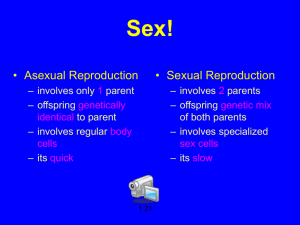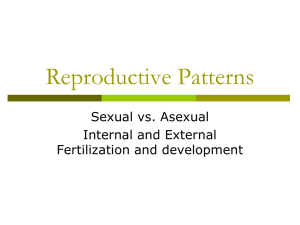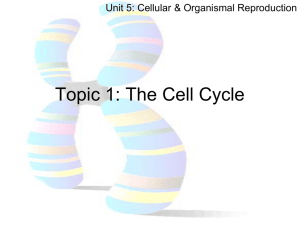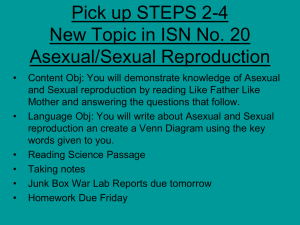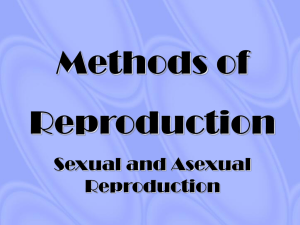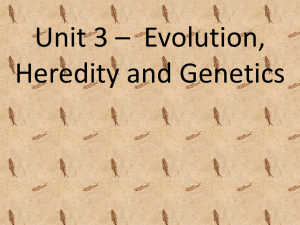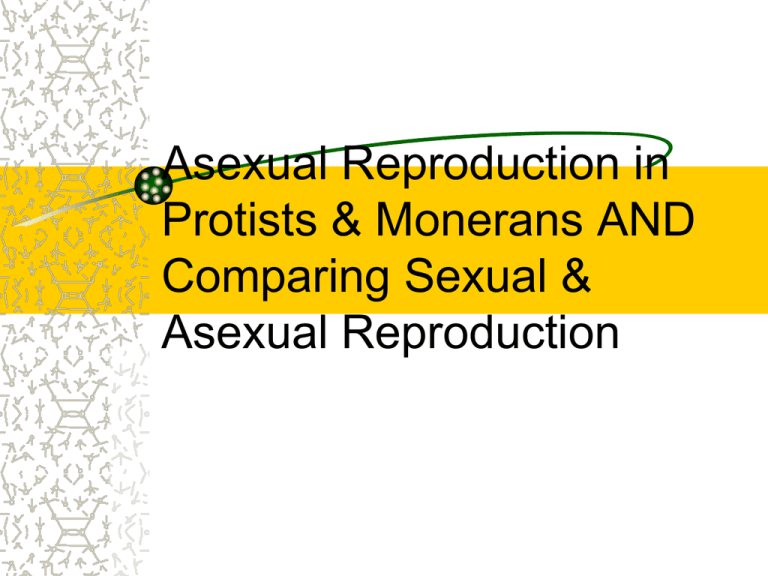
Asexual Reproduction in
Protists & Monerans AND
Comparing Sexual &
Asexual Reproduction
GOAL
To compare sexual and asexual
reproduction in animals, protists and
monerans
Define (glossary p. 731)
fertilization
Facts: previous knowledge
1.Male sex cell is called the
__________
2. Female sex cell is called the
__________
3. All body cells have ________
chromosomes; sex cells have _____
each so when they join together there
will be a full set of 46
Animals: Sexual Reproduction
Sexual
Reproduction in
Animals
1. Animals, some plants, fungi,
protists
2. 2 parents= male & female
3. Sex cells (Gametes)
– Male= sperm
– Female= egg
Sexual Reproduction Process:
Sperm fertilizes
egg to form zygote
(single cell)
Zygote divides
repeatedly until
it forms an
embryo
Sexual Reproduction Process:
Embryo
develops into
a fetus (begins
to look like
parents)
Offspring is
born
Sexual Reproduction Diagram
Create a flow chart with pictures to explain the
process of sexual reproduction. Label the sperm,
egg, zygote, cell division, embryo & fertilization point
Fertilization Animation
Fertilization Animation
Numbers of offspring
Humans- 1
Elephant/horse- 1
Cat- 4/5
Dog- 1/12
Animals: Sexual Reproduction
5. Appearance of offspring
• a. Two parents
Sexual
Reproduction in
Animals
•
b. Two sets of chromosomes
•
c. Two sets of genes
•
d. Genes mix- traits from both
parents
Animals: Sexual Reproduction
Sexual
Reproduction in
Animals
6. Number of chromosomes
•
In human body cells = 46
chromosomes
•
In human sex cells = 23
chromosomes
Animals: Sexual Reproduction
Sexual
Reproduction in
Animals
7. Egg (23) + sperm (23)
= 46 chromosomes
Animals: Sexual Reproduction
Sexual
Reproduction in
Animals
8. Once fertilization is
completed, zygote divides by
mitosis (asexual
reproduction)
Review: Sexual Reproduction
in Animals
Describe the
process of
fertilization
Review: Sexual Reproduction
in Animals
Describe the
development of
an organism
immediately
after fertilization
Review: Sexual Reproduction
in Animals
Compare the
number of
chromosomes in
sex cells with the
number of
chromosomes in
body cells
Asexual Reproduction
Methods
Asexual
Reproduction
Algae, amoeba
bacteria
growing animals, plants and
fungi
Asexual reproduction
Cloning
http://www.brainpop.
com/science/cellular
lifeandgenetics/cloni
ng/
Binary fission
http://www.classzon
e.com/books/hs/ca/s
c/bio_07/animated_
biology/bio_ch05_01
49_ab_fission.html
Asexual reproduction
Budding
http://www.youtube.
com/watch?v=489C
Sop00sY
Regeneration
http://www.youtube.
com/watch?v=f7cXe
WxxfD4&feature=rel
ated
Asexual reproduction
Asexual
reproduction
http://www.brainpop.
com/science/cellular
lifeandgenetics/asex
ualreproduction/
Asexual Reproduction
Methods
Binary
Fission
1. Bacteria
2. Organism divides in half
3. 2 identical daughter cells
produced (half the size of their
parent)
4. Daughter grows to parental
size- then divides
Binary Fission Images
Binary Fission Images
Binary Fission Clips
Asexual Reproduction
Methods
Budding
1. Small bud grows out of parent
cell (with identical DNA)
2. Bud breaks off when large
enough
Ex. Hydra, potato
Hydra Budding Images
Asexual Reproduction
Methods
Regeneration
1. Living things repair themselves
by growing lost body parts from
remaining cells
2. Ex: lobsters, starfish, lizards
Regeneration Pictures
Asexual Reproduction
Methods
Cloning
1. Making exact copies of
organisms – gets DNA from only
one parent cell
2. Ex. Dolly the sheep
Cloning pictures
Comparing Asexual & Sexual
Reproduction
Create a T-chart to compare the following:
– How many parents?
– Are sex cells needed?
– What numbers of chromosomes are involved? (at
the beginning and at the end)
– Are offspring different from or identical to parents
and why?
– What types of organisms?
What are the advantages of each:
AsexualSexual-
ANSWERS:
ADV.
Sexual- variation in traits
evolution
asexual- no mate needed
DISADV.
Comparing Reproduction
Types
ASEXUAL
– 46 --> 46
– One parent
– Cells produced are
identical to the
parent- no gene
mixing
– No
– Some plants,
animals, and fungi
SEXUAL
– 23 + 23 --> 46
– Two parents
– Cells produced are
different from their
parents- due to gene
mixing
– Yes
– Bacteria, amoeba,
algae, growing
plants, animals, and
fungi
Websites
Animal Reproduction Animations
Animal Life Cycles


